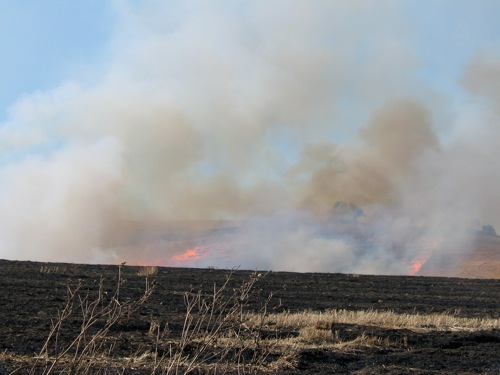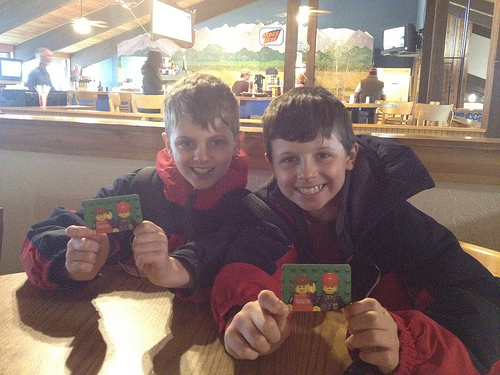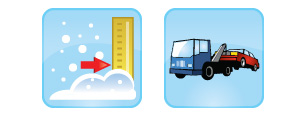What the public way means in the networked age
Let’s start here. I want our relationship with public objects to feel like this.
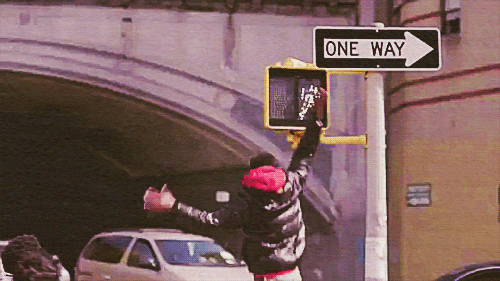
It does not feel like this currently.
But let’s back up to a street scene in Chicago in the late 1930’s for context.
You’re walking at a clip downtown because it’s storming. You hunch over and tilt your umbrella into the sheeting rain as people scamper for cover and taxis. Luckily your destination is this building and you know, thanks to having walked this route before (and a clever architect), that you don’t even have to look up to figure out that you’ve arrived.
On both the Clark and LaSalle sides of the Field Building (as it was originally known) are symbols in the sidewalk pointing to the entrances. F for Field, arrows for which way to turn.

If noticed at all, these small, plain sidewalk icons could easily be mistaken for architectural decoration. But they were designed specifically around the umbrella use-case.
You may also have seen compass markings in the sidewalk just as you step out of a subway stop. Easy to overlook, but incredibly useful if you’re disoriented emerging onto the surface grid.
These examples represent embedded, passive information that’s not screaming for attention but placed precisely where you might need it. It’s information design in the physical architecture of the public way.
Today there’s a new usage scenario. You’ve seen it a thousand times. Urban pedestrians staring down at their smartphones, half-in and half-out of the moment in what Amber Case calls “temporarily negotiated private space”.
Maybe the F-marks would be missed by these otherwise engrossed city-goers, but they are a great example of ambient information in city environments. And we’re going to need a lot more of that as we increasingly negotiate our public space through a mixture of physical and digital awareness.
What’s new is the sheer volume of mobile, networked technology in our public spaces (and everywhere else). It’s an opportunity to “embed” information in new ways and to customize it to very specific places and moments in time.
Typically sensors and wireless connectivity claim the spotlight in discussions of the networked city, but I’d argue we’re missing a real opportunity not to use new technology to make the built environment more legible.
Why?
Most obviously, embedded digital information can aid in safety. The video of the girl in China on the phone falling through the sidewalk is one end of a spectrum of examples, most of which are instances of obliviously texting pedestrians falling off piers, walking into traffic, or smashing into one another. And it’s probably getting worse.
Rudimentary systems that might prevent such calamity do exist, but with a focus on motorist, rather than pedestrian, alertness at crosswalks. Crosswalks and Xwalk both flash lights to make the zebra stripes more prominent. You could imagine a more nuanced system which assumes pedestrians are looking down (at their devices) and flashes or changes color when the traffic signal is about to turn green. Interaction with devices via Bluetooth or NFC is not inconceivable either. Scenario: if the device is engaged in use, assume distraction, and alert accordingly. A responsive public way that’s in a positive feedback loop with its users.
Accessibility is another category of use for the responsive public way. Crosswalk design for the visually-impaired is not a problem for individual intersections — high-pitched chirping signals — but it doesn’t scale for large cities. The cacophony of a city full of bleating traffic signals would be the kind of noise pollution that causes New York City to impose fines on honking motorists. But if the crosswalk itself was open to digital development you could imagine white canes, phones or other personal devices alerting the visually-impaired pedestrian that the street was open to cross.
Basic convenience may be an even better rationale for a legible (and writable) public way. Why perform a digital transaction at a modern-day parking meter when you can text it or use an app to pay before leaving your car? Think driving snowstorm. Think having three kids in the backseat and the meter is 100 meters away. Think not having a credit card at all. All good reasons. This is getting closer to the high-five moment of a digital public way.
If we begin to think of a truly responsive public way we have to rethink what “public” means in the digital age. The analogy here is a city’s information. Getting at a city’s vital signs and the records of public servants has been a long slog for transparency advocates. In the days of exclusively paper-based record-keeping Freedom of Information legislation was one of the only ways to do anything with public records. Then came digitization and the same barriers obtained. You had to go through legal maneuvers to get at it — and even then it was not particularly useful beyond reading it. PDF’s largely made this information static, opaque to computer-aided parsing and tabulation. But the advent of machine-readable online document standards and a shifting political climate towards the value of open government has unlocked torrents of data in cities around the world. What’s come of this can only be described as a new kind of civic engagement: open data has bred an ecosystem of secondary applications, analysis, and interactions that governments could never conceive of, much less produce themselves.
The infrastructure and objects of our current public way are in their paper period.
Certainly, there are screens scattered throughout. Public transit leads the way here. Buses that generate location data, subway platforms that announce arrival times, etc. There’s some digital marketing along the way that occasionally serves up alerts or public service announcements. And every so often you’ll see an advertiser attempt something (barely) interactive — a QR code for more information, typically. But there’s no platform in the software and open data API sense of the word in the physical city.
And yet, many of our public objects are networked — the foundational requirement for a responsive system. Public bikes and bike stations, bus shelters, parking meters, and of course every light pole with a public access point clamped to it — all these things are network endpoints. But they’re not interconnected and they are not open to interaction. There’s no interface for third-party development.
Some City of Chicago Department of Transportation construction projects feature NFC and QR codes on signage onsite that link to information about the project. That’s the paper stage, incunabula. The vision is for direct access to mobile-optimized applications for business permits in situ. More promisingly, the information system underlying the upcoming roll-out of public bike sharing in Chicago (e.g., real-time bike availability info) has an open API. 4,000 bikes and 400 stations will be open to development and interaction in the way that the city’s open data portal is. A step away from paper towards platform.
There’s an inverse to this dynamic, equally ripe with opportunity. The impact of city-dwellers’ use of digital technology when out-and-about has yet to make a any real impact on physical urban design. Mayor Nutter of Philadelphia got a good laugh last year when he released an April Fools Day video touting newly-striped “texting lanes” on sidewalks. But that was parody (though thinking about it a little longer makes it slightly less parodic).
Surpassingly few cities and urban design firms actually give thought to how technology is changing the way the city is used. Which is odd, since so many of the problems that online companies grapple with — what it takes to create a vibrant, safe public space, as one example — have pretty well been solved, if not perfected in implementation. There’s the Facebook approach, which is essentially suburbia: a gated network of affinity that disallows chance encounter and serendipity. And there’s the Twitter approach which is all about non-reciprocal engagement and diversity. (It’s no coincidence that the founder of Twitter is a dilettante urbanist.) This is a choice between mall culture and real urbanism and I fear that our information architects and built environment architects have not even begun the conversation.
The sidewalk is the original social network and its lessons have much to teach the designers of our digital overlay of public spaces.
In Chicago, it’s coming together: a robust open government community of engaged developers (and increasingly savvy residents) fueled by an administration actively publishing data and working to make sure the vendors of our public objects treat it as a platform. There’s a long way to go, but we’ve etched some symbols in the pavement and we’re hoping you follow our lead.
High five!
(X * X = Chicago). Solve for X.
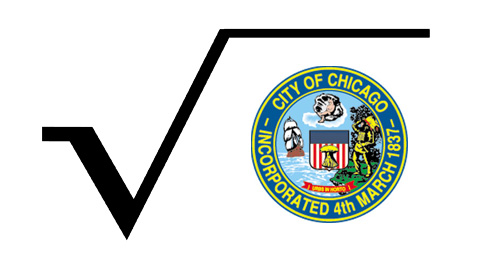
Recently, as we sometimes do to fill time, my family and I were asking each other trivia questions. My six-year-old daughter piped up with one from left field that made me laugh out loud — then had us thinking for the rest of the evening. She asked:
What’s the square root of Chicago?
Didn’t have an answer for that one, but it was ready-made for my Twitter followers and they did not disappoint.
The literalists looked at ranking and square mileage, but perhaps this town if squared might be us:
@immerito it’s Sunbury, North Carolina population 1,645
— Zach Kaplan (@zkaplan) February 17, 2013
Some took a geographic angle. Logan Square, the Loop itself and my favorite:
@immerito Fort Dearborn. It was a square. Planted the roots of our city. twitter.com/tomkompare/sta…
— tom kompare (@tomkompare) February 18, 2013
The most interesting approach was formulated by Seth Lavin. He put it two ways:
For the verbal minds, it’s whatever makes this sentence true: “In Chicago, we blank blank.” (e.g. we reform reform)
In other words, (X * X = Chicago). Solve for X?
It’s a head-scratching formulation, in some ways. What thing, what action, what verb does Chicago do to the same thing, action, verb that makes this city uniquely us?
Some suggestions:
- defeat defeat
- discriminating discriminators
- perfect perfection
- disempower disempowerment
- build buildings
- plant plants
- bully bullies
- reform reform
- red line (huh?)
No clear winner to my mind, but I sure did like Josh Davison’s wordplay: “polish Polish”. As in polish off Polish sausage. My wife noted that the reverse has been historically true with Polish housekeepers being employed to polish things (among other tasks).
All good fun, of course, but this exercise may be an epiphenonemon of the very real debate over whether cities can be mathematically described in a useful way. That’s quite another post. For now let’s revel in the oddball question of a six-year-old kid.
Giftmix 2012
Keeping the flame alive, here’s the year-end giftmix. You know the drill. It ain’t the best of 2012 and it’s barely generically coherent, but these are the tracks that either (a) made people on the dancefloor happy at Beat Research Chicago or (b) were in one way or another special to my family this year. (You’ll gather that I took my son to his first concert, Roger Waters doing the entirety of The Wall this year, for instance.) Hope you enjoy.
Tolva Giftmix 2012 by Immerito on Mixcloud
In The Flesh? – Pink Floyd
Flutes (Sasha Remix) – Hot Chip
Chime/Crime (Live in Australia) – Orbital
Sweet Thing (Adam Faz Dub Remix) – Tenor Fly & Dreadsquad
Whiskers – Gemini & Feed Me
Breakn’ A Sweat (Zedd Remix) – Skrillex & The Doors
Random – Gary Numan
Puttin’ On The Ritz (Club Des Belugas Remix) – Fred Astaire
Keep Pounding – Mooqee & Pimpsoul
Baby Battle Scratch – Lemon Jelly
Good Gone – K Theory
Ana Ng – They Might Be Giants
Debaser – Pixies
Bohemian Rhapsody – Queen
The Trial – Pink Floyd
Outside the Wall – Pink Floyd
Full stream at Mixcloud, above. MP3 for download here.
Happy holidays and a healthy, propserous new year to you all!
Scorched wheat
In 2007, as my parents and I were exploring the area around my family’s home town in southern Italy, we drove through an ominous stretch of landscape. It was Illinois farmland meets Mauna Loa, cropland burning as neat lines of flame munched what remained of threshed wheat into soil-enriching ash.
It’s an image that stuck with me, reminding me of the controlled burns my family does to its prairie in Galena, IL and adding an eerie atmosphere to what might be my favorite photo of the volcano Vulture on whose slope our ancestral village sits.
Turns out a minor culinary trend has been sparked by what we saw. La Cucina Italiana recently featured the pasta possibilities from Grano arso (“burnt grain”), specifically from Puglia (just north of where we were in Italy). It’s basically toasted wheat, but the explanation of the tradition is fascinating. It’s said that “burnt” pasta dates to a time when land-owning nobility would allow peasants to scour the fields after a wheat harvest (and burn-down). Blackened grains would be collected for a literal poor-man’s pasta. Alternate versions of the origin of this pasta state that poor workers would sweep up the milling room floor for crumbs, toasting what they gathered, or simply take the remaining burnt flour from the decks of bread ovens.

If you’re hardcore and want to scorch your own wheat for pasta-making, I applaud you. We did not do that, as at least one importer sells it.
The taste? Imagine an al dente version of a nicely toasted pizza crust. Yummy. We made an incredibly simple dish from it — essentially orecchiette, broccoli, pepperoncini, and garlic — and it was a flavor-bomb. (Here’s the recipe we used.)
So, yeah, if you’re in to off-beat Italian pastas, I’m here to recommend grano arso. Perfect winter tastiness.
Negril, Jamaica
May 2012. Eight couples of college friends all turning 40 this year, a 16th wedding anniversary, rum, reefs, and a commemorative mix of reggae and its descendants, below.

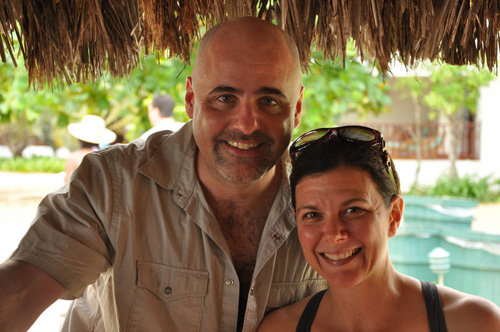

We kept the spirit alive with a dinner party this weekend after returning home. Jamaican theme, of course.
- Shellfish watermelon ceviche (with scallops and shrimp, photo below)
- Jerk vegetables (summer squash, zucchini and mushrooms) and chicken skewers
- Red snapper in coconut curry broth
- Coconut lime rice
- Avocado, orange and goat cheese salad
- Appleton rum cake
- Mango sorbet
- Rum cream over ice

Full photo set here.
Drums keep pounding a rhythm to the brain
Mix from last night’s always-enjoyable overlap of Beat Research and Urban Geek Drinks. A few older tracks (and a K-TEL easter egg) laced into the stew. Enjoy.
Supertramp on the brain
I just realized I love Supertramp and always have. WTF. What else do Ilove that I don’t know that I do?
— John Tolva (@Immerito) March 21, 2012
Really the only way to get this out of my head was to mess with it.
Done.
The Brick Brothers
Almost exactly a year ago my sons asked me what “investing” was. A strange question from a 9- and 7-year-old, but I was impressed by the curiosity and it seemed timely given the banking implosion.
I lost the boys midway between arcane regulation and exotic financial instruments, but they were intrigued with the idea of a business more complex than a lemonade stand. And then they wouldn’t shut up about starting one, embarking on an entrepreneurial brainstorming session whose intensity would have made a venture capitalist smile. (Or back away slowly.)
The idea, fairly speedily arrived at, was to build on something the kids had been staring at all their lives. In the days following the birth of each of the three kids I built grayscale mosaics of their birth photos out of 1×1 LEGO bricks. They’ve hung on the wall ever since. The business idea, quite simply, was to build these mosaics for others.
And so was born The Brick Brothers.
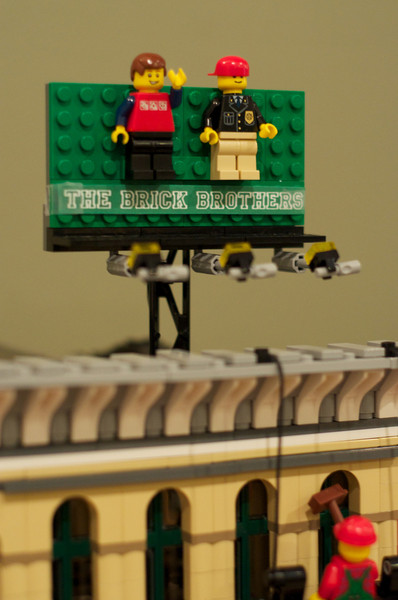
Marketing ideas are modeled first in bricks, naturally
Listen up, folks. Here’s where I divulge trade secrets.
We built the site on the superb Shopify platform. It accepts photos uploaded from customers who purchase a completed mosaic or just the raw materials.
We then use an open source application call PicToBrick to generate a number of gridded (48×48), reduced-color images. The image that comes closest to capturing the essence of the original photo is chosen and printed out as a guide for the assembly.
Then the boys snap the pieces onto the baseplate, following what is essentially a color-by-numbers schematic. Dangerously, this is mind-numbing (and finger-numbing) but also requires attention to detail: if you pop the wrong brick in place and only notice it several rows later it’s a huge effort to remove the studs. What makes this a less-than-rare occurrence is that you really only get a sense of the overall image by moving away from it. When you’re up close snapping away it is often impossible to notice an error.
The whole effort takes about 4-6 hours depending on distraction. Then we package up and ship out.
One hurdle — aside from child labor laws — has been finding the 1×1 bricks in bulk cheaply enough. LEGO doesn’t sell in bulk to mere mortals and those bins at their stores contain very specialized bricks. Luckily there’s a massive ecosystem of LEGO re-sellers online, centered on a marketplace called BrickLink. But there’s no single supplier. It’s a scramble to stay well-inventoried and not break the bank.

The boys' first investment in The Brick Brothers (from relative strangers at a Cubs game), July 24, 2011
It should be obvious we’re not in this little enterprise for profit, but I’d continue the business with the boys even at a financial loss given its many lessons: time-management, expenses vs. revenue, the importance of marketing, the concept of chiaroscuro, how easy it is to be driven insane by tiny LEGO blocks, etc. We’re having fun and not losing money. Can’t ask for much more than that.
Follow along via Twitter here.
Shovel Ready
Heading into winter late last year we were told that it was going to be one for the record books. And so it has been. Temperatures have yet to go into minus territory and there are towns in Texas with more snowfall than we’ve had. It’s downright bizarre.
But I’m a believer in meteorological karma. Sure, we’re trending way behind average snowfall to date. But that doesn’t mean Old Man Winter can’t go for a late game Hail Mary. I’ll put away the shovel in June.
That’s basically the philosophy of preparedness behind a slew of winter-focused applications created by the City of Chicago over the last weeks at chicagoshovels.org.
It’s all about scales of sharing, really. Last year’s blizzard showed a side of our city rarely talked about: authentic neighborliness. Chicagoans came to each others’ aid, made friends on stranded public transit, and generally bonded in the face of potential calamity. The idea behind Chicago Shovels is to facilitate this latent drive to be good neighbors, to offer tools for sharing in the common experience of a heavy snowfall.
The sharing extends to the code itself. Civic-minded volunteers came together to build parts of Chicago Shovels and some of the code itself was shared via a Code for America-developed project in Boston. And, of course, we’re sharing what we’ve built on our Github account. Cross-municipality, open source development is the way forward.
Many different threads of Mayor Emanuel’s technology mandate are bound together in Chicago Shovels.
Plow Tracker, the first app to launch and certainly the most popular, is a good case study in open data for transparency and accountability. While I talk a lot about open data as a driver of economic development and as analytics fodder, the lesson from Plow Tracker’s launch — and the record-shattering traffic it drove to the city’s website — is that we shouldn’t forget that the ability to peer into the workings of government is the first and possibly most important function of open data.
The Tracker is a good illustration of our open data initiatives: more information is always better than less. If there are patterns to be found, they will be. And no matter what they are, such analysis leads to a more efficient city government.
Plow Tracker is only on during storms, of course. It shows where plows are in real-time with a bit of information as to the city “asset” you are looking at. This is normally salt-spreading plows, but in bigger snow events can include garbage trucks with “quick-hitch” plows attached and even other city vehicles outfitted to plow. As Chicagoist pointed out, watching the map can remind you of a certain popular video game from the 1980’s.
Feedback from the public, coverage in the press, and inquiries from other cities has been overwhelmingly positive. Many have asked for increased functionality, such as a visualization of what streets are cleared. This is tough, as we do not have real-time data on the status of city streets, except what can be visually inspected via cameras and the plow drivers themselves.
Undaunted, the team at Open City took the Plow Tracker data and created Clear Streets. Where Plow Tracker shows where the plows are, Clear Streets shows you where they have been. (If we’re keeping with the gaming analogies, this is to Etch-a-Sketch what the Tracker is to Pac-Man.)
Clear Streets is obviously useful and a great example of the ecosystem of civic developers that are growing on the periphery of government thanks to open data. And with Chicago’s digital startups reaching critical mass and real attention from venture firms, the city is doing its part in nurturing “civic startups” like Open City. (Here’s a clip of the Open City crew and me discussing all this on WTTW’s Chicago Tonight.)
A last note on (and lesson from) the Tracker: context is key. The little text blurb above the map is really crucial to understanding what you are looking at. As an example, sometimes plows are deployed before it starts snowing for preemptive salting of bridge decks. If you did not have this information it would be difficult to rationalize the placement of plows. It’s a lesson for open data in general. The more data, especially real-time data, the more context matters.
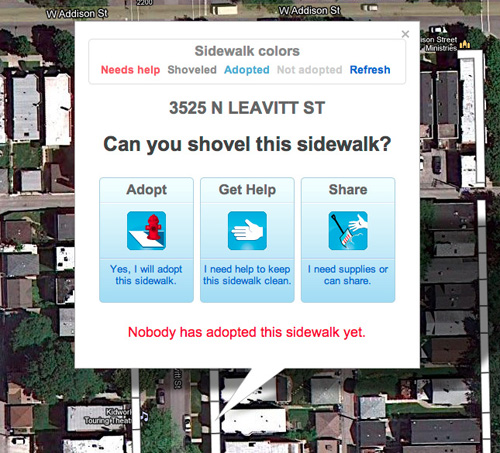
Adopt-a-Sidewalk
The site’s most recently launched app, Adopt-a-Sidewalk, represents the original idea for Chicago Shovels.
Last fall, as Chicago was preparing to become a 2012 Code for America city, we learned about a side project from the Code fellows in Boston. Early in 2011 they had arrived to work on a project with Boston schools but were met with a blizzard. So they built Adopt-a-Hydrant. This idea was to encourage residents to “claim” fire hydrants for shoveling out during the winter. Simple, smart, the right thing to do. And the code was open source.
So we took it with the idea of creating something similar but focused on the public way. We thought we could go a bit bigger than hydrants. See, the Chicago Municipal Code requires residents and businesses to shovel the sidewalk in front of their property. So why not allow them to claim it or claim someone else’s — or ask for help? Claim a parcel, mark it as cleared, track your achievements.
Alas, winter in Chicago has long been associated with “claiming” parts of the public way. Adopt-a-Sidewalk attempts to capitalize on this impulse for the good of pedestrians, minus the lawn furniture and household detritus. (And we’re not the only ones trying to expand the definition of wintertime dibs to the sidewalk itself.)
Again, this has been one weird winter. Snow is scarce and temps are routinely above 40. If it ever does snow again, though, Adopt-a-Sidewalk is ready to promote community responsibility and actual sharing. We partnered with local startup OhSoWe to integrate neighborhood-based sharing into Adopt-a-Sidewalk. Locate your sidewalk — or a parcel you’d like to help out on — and instantly see who around you is willing to lend shovels, salt, even a snow blower.
It’s been noted that the City creating its own apps is a bit of a departure from our data-centric approach to date. (Noted, I might add, in the most strenuous way, with real constructive criticism from engaged residents.)
The truth is that having Mother Nature on the critical path to deployment is a tough, stressful thing. (She’s neither agile nor a fan of the Gannt.) We knew snow was coming and we knew we needed Plow Tracker up for the first major storm. Launching an app was something that could not slip. Adopt-a-Sidewalk, while built with volunteer assistance, was partially an effort at proving that municipal code sharing is real and viable. Both of these builds demonstrate that the City will create apps when there are reasons to do so. But that in no way detracts from our belief that the community and the marketplace are the sources of real innovation that come from Chicago’s open data.
And we have that too. Chicago Shovels’ last major app category showcases community-built applications. The two most useful are actually wintertime reworkings of earlier incarnations.
Last year civic über-developer Scott Robbin built SweepAround.us, an app for alerting residents the night before the City would be sweeping streets in their area so they could move their cars from the street (avoiding a ticket). This was the perfect app for tweaking to accommodate a system for alerts about the City’s 2″ Snow Parking Ban. SweepAround.us became 2inch.es.
Similarly, Robbin’s wildly popular wasmycartowed.com was updated to include automobile relocations due to snow emergencies.
A slew of winter-related resources round out the site, including a number of winter-related apps from last year’s Apps for Metro Chicago competition, information on how to become part of the City’s official volunteer “Snow Corps”, one-click 311 request submission, FAQ’s, and subscription to Notify Chicago alerts.
Chicago Shovels is the city’s best example to date of the value of open data. Transparency and accountability (Plow Tracker), reuse and sharing (Adopt-a-Sidewalk), business creation (Clear Streets), efficiency and ease-of-use (2inch.es and wasmycartowed.com) — these are the outcomes of a policy of exposing the vital signs of the city.
Now if it would only snow — and stick.
“Can you switch to Pandora?”
Beat Research Chicago continues. And wow is it fun. But can you determine where in this set I was asked to stop by the bouncer? (I did stop. Quintessential needle scratching off the record. Finished the recording at my desk when I got home.)

